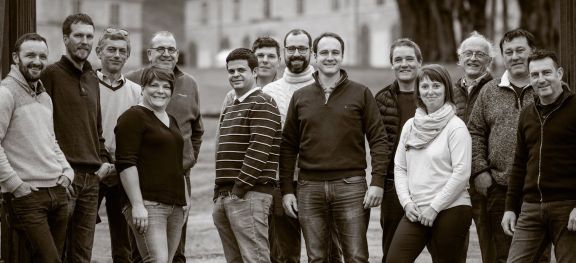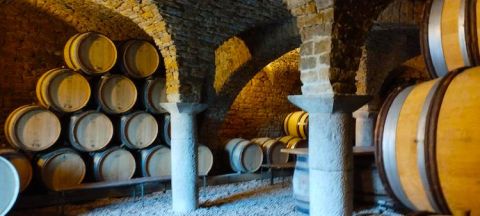Jean-Luc Mouillard, Le Curieux 2020 Côtes du Jura

A lightning bolt of fresh, mineral flavour from the far eastern reaches of France.
From €15, £25.20, 230 Danish kroner, AU$71.50
Find this wine: Wine-Searcher seems to have bailed on us with this wine, but if you follow the links on the prices above, you’ll find the wine.
Jean-Luc Mouillard grew up in the Jura, where his family focused on dairy cattle, and sold the grapes they farmed to the local co-op. As soon as Mouillard finished school, however, he headed off to study winemaking. He came back home to Jura after a year’s experience in Beaune and established his own domaine in 1991.
In a slow, thoughtful way, he’s built up the estate over the years to an 11-ha (27-acre) estate with 16th-century cellars and a modern winery. It’s very much a small family affair – he works with his wife, Annie, and his son, Mathieu, who joined them in 2018 after finishing his own oenology studies. They took a lutte raisonnée approach to farming until 2020, when they began to convert to organic; the 2023 vintage will be the first to be certified organic.
Mouillard makes a range of wines, including crémant, red and sweet, as well as Chardonnay and vins jaunes. But the wine that brought him to my attention was his Savagnin ‘ouillé’. As he puts it on his website, ‘For those who are wary of Savagnin de voile [vin jaune], this is Le Curieux, a Savagnin that is not aged under flor, but spends time in barrel.’
I have a real soft spot for the salty, deep-gold flavours of the Jura’s Savagnin vin jaune and oxidative whites. But this particular bottling, made in the more modern, ‘fresh’ mode of Savagnin, really startled me. It is bold, tenacious, defiantly gutsy.
My tasting note started with curiosity: ‘Such an interesting nose. Smells of sour cream, acacia blossom, goat-milk butter. With a bit of toastiness – like thickly buttered toast popped under the grill until dark golden brown.’ And then I tasted it and took an abrupt gear change. The wine was rigidly, shockingly mineral. It was, at first, a lightning bolt of white-citrus-drenched, firm, three-dimensional structure. Dramatic, uncompromising. But what I found interesting was that, despite the chest-slam of minerality and structure, it wasn’t a severe wine. There was none of the spartan character that I often associate with bone-judderingly mineral white wines. Instead, the wine seemed to fill the mouth, feel the space, insert itself into every nook and cranny with a cornucopia of flavours: chamomile flowers, talc, bergamot, quinine bitters, brine. The fruit had a green-peaches crunch, but it came with a shimmer of sweet-lime-sherbet acidity and because of that it felt somehow generous and full.
Over a period of a week, it neither opened up nor fell over. It just stayed and stayed and stayed and stayed – as steady as marble. If I’d had the self-restraint or a spare bottle, I’d love to have seen just how long it could last once opened. I have a feeling it would manage several weeks. It’s a tenacious wine. It has temerity.
It’s not a wine for knocking back, though. You want to give this wine time, thought, and you really want to pair it with food. I love Victoria Moore’s description of Savagnin in my much-thumbed copy of The Wine Dine Dictionary, as ‘sometimes almost salty and hazelnutty, reminiscent of hay and white peach, but also direct and focused as a blade’. I agree. She suggests pairing it with Vacherin Mont d’Or, fondue, trout with hazelnuts and leeks, or parmesan-crusted chicken. To be frank, a straight-forward, butter-and-herbs-under-skin roast chicken would be great with this, but I’d probably go even simpler than that. To showcase a gem like this? Get the best organic baking potatoes you can find, rub them with salt and olive oil, bake them until they are as silky as cream on the inside, open them up and slather them with a heart-stopping amount of unpasteurised, salt-crystal-crunchy butter from grass-fed cows and top with sour cream from those same cows*. Light the candles and dim the lights, turn off your phone and lock the door. Tuck a large napkin into your collar, pour this wine (not too chilled) into a beautiful glass. Get ready to wipe your chin. And your fingers. And butter smears off the rim of the wine glass. I promise you, you won’t care. Sometimes the best way to drink a beautiful wine is this way.
Wanderlust imports and sell the wine in the UK, Vintage59 imports the wine in the US (although in the US it’s labelled L’Ouillé, not Le Curieux), Vinilicious sells it in the Netherlands, The Wine Company sells it in Denmark and PS Wine Selections sells it in Australia.
If you can’t get hold of Le Curieux/L’Ouillé, then Jean-Luc Mouillard’s Floral is another delicious ouillé-style wine that he makes, but this one is about 90% Chardonnay and only 10% Savagnin. It is much the same price and is also imported by Wanderlust in the UK and Vintage59 in the US, although it’s more widely available in the US (Roy Cloud of Vintage59 tells me that he’s yet to persuade American wine drinkers of the wonders of Savagnin). This is, however, a uniquely Jura Chardonnay – nothing like Chardonnay you’d drink from Burgundy or anywhere else in France, the US, or indeed anywhere else at all.
*Trust me when I insist on organic and grass-fed – when you’re working with unadorned veg and dairy ingredients, the flavour you’ll find from organic and grass-fed is everything.
Find reviews of a wide array of Jura wines – sparkling, white, red, ouillé and not – in our tasting note database.
Photos courtesy of Domaine Mouillard.
Become a member to view this article and thousands more!
- 15,407 featured articles
- 274,946 wine reviews
- Maps from The World Atlas of Wine, 8th edition (RRP £50)
- The Oxford Companion to Wine, 5th edition (RRP £50)
- Members’ forum
- 15,407 featured articles
- 274,946 wine reviews
- Maps from The World Atlas of Wine, 8th edition (RRP £50)
- The Oxford Companion to Wine, 5th edition (RRP £50)
- Members’ forum
- 48-hour preview of all scheduled articles
- Commercial use of our wine reviews



